
Una descripción general de las palabras clave sobre el tráfico. Aquí puede buscar fácilmente palabras clave y definiciones que aún no conoce.
More subjects
The Cadillac XLR is a front-engine, rear-drive, two passenger roadster manufactured and marketed by Cadillac from 2003 to 2009 across a single generation — and noted for its power retractable hardtop, Bulgari designed interior instruments, head-up display, adaptive suspension marketed as Magnetic Ride Control, rear-mounted transmission and near 50/50 front-to-rear weight distribution. As Cadillac's flagship model, the XLR was introduced at the 2003 North American International Auto Show and began production with model year 2004 — foreshadowed by the 1999 Evoq concept. Sharing the GM Y platform and manufactured alongside the Chevrolet Corvette in Bowling Green, Kentucky, the two cars also share hydroformed perimeter frame and composite bodywork construction — though each have unique exterior and interior styling, suspension settings and engine. The XLR was the first production Cadillac with radar-based adaptive cruise control (ACC) and the first to offer both heated and cooled seats. The XLR was nominated for the North American Car of the Year award for 2004. (Source: Wikipedia.org, CC BY-SA)
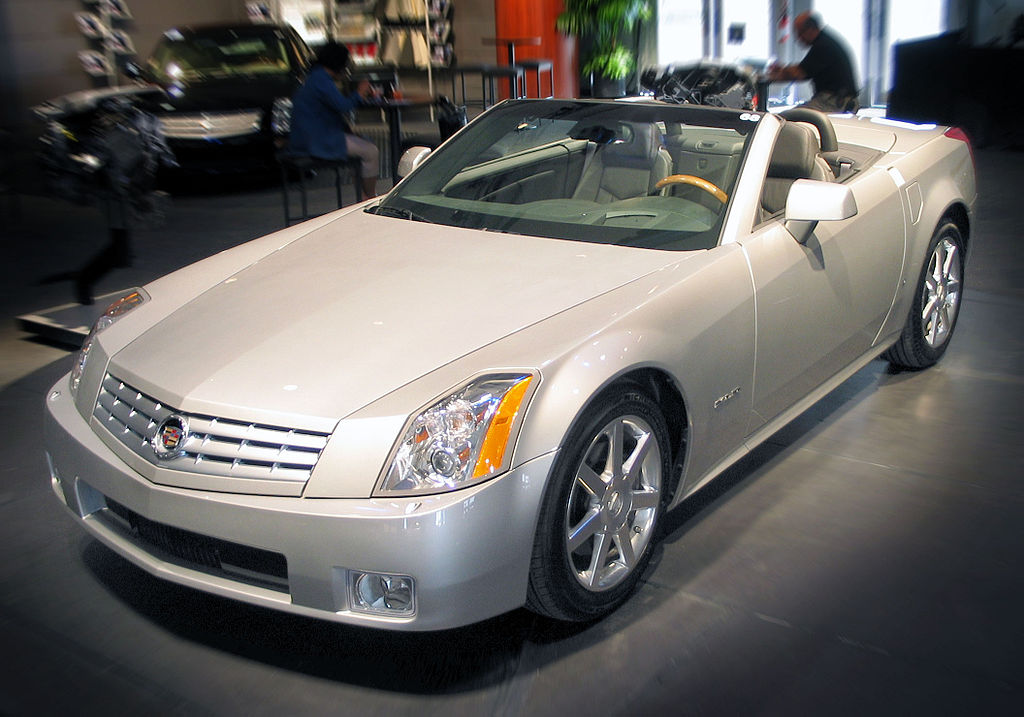 © Wikimedia.org/Sirimiri, CC0
© Wikimedia.org/Sirimiri, CC0
The Cadillac XT5 (short for Crossover Touring 5) is a compact luxury / D-segment crossover SUV manufactured by General Motors. It was introduced at both the Dubai Motor Show and LA Auto Show in November 2015. The XT5 replaced the Cadillac SRX crossover when it was launched in spring 2016. It is the second model to use Cadillac's new alphanumeric naming scheme (after the CT6) and the first in the Crossover Touring (XT) series. The XT5 is manufactured at GM's Spring Hill Manufacturing plant. The Chinese-market XT5 is manufactured in Shanghai by SAIC-GM. As of 2017, the XT5 was Cadillac's best selling model in the United States and globally. The XT5 features technology such as a streaming video rear-view mirror, 360° view backup camera, and the first application in a Cadillac of GM’s Electronic Precision Shift, which replaces the standard hydraulic shifter with an electronic controller. This, together with a new lightweight chassis, results in a weight savings of 278 lb (126 kg) versus the outgoing SRX. (Source: Wikipedia.org, CC BY-SA)
The Cadillac XTS (short for X-Series Touring Sedan) is a full-size, four-door, five-passenger, front-wheel drive or all-wheel drive luxury sedan from Cadillac based on an enlarged version of the Epsilon II platform shared with the Buick Lacrosse and Chevrolet Impala — and manufactured from 2013–2019 over a single generation. Replacing the smaller Cadillac STS and larger DTS, production began in May 2012 at the Oshawa Assembly Plant and launched in June as a 2013 model. Marketed with left-hand drive in the United States, Canada, Mexico, China, and the Middle East (except Israel), the XTS was also assembled by Shanghai GM, with production beginning in February 2013. (Source: Wikipedia.org, CC BY-SA)
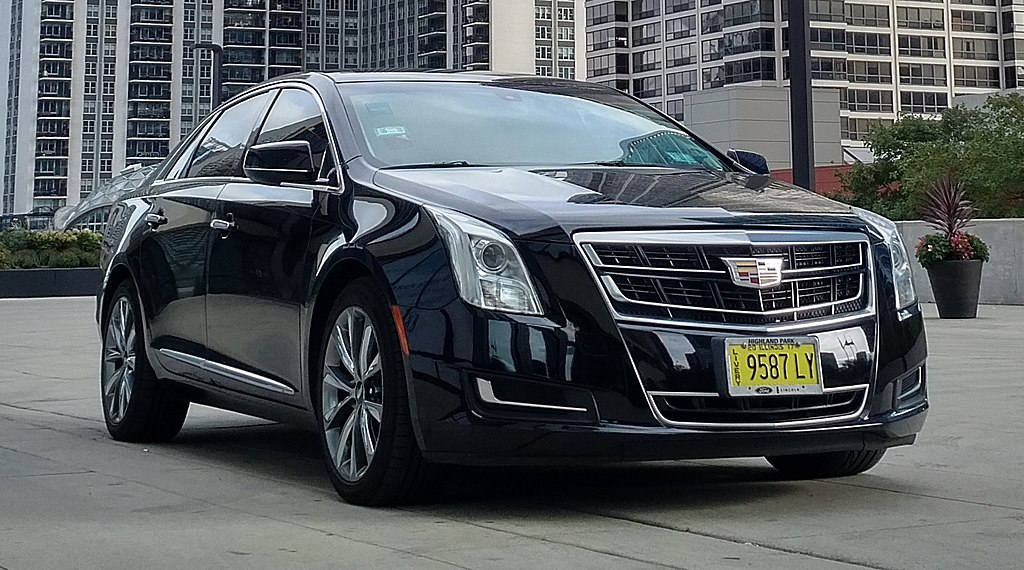 © Wikimedia.org/Ruben de Rijcke, CC BY-SA
© Wikimedia.org/Ruben de Rijcke, CC BY-SA
The Cadillac DeVille is the nameplate used by Cadillac over eight generations, originally used to designate a trim level of the 1949 Cadillac Series 62 and later to designate a standalone model in the brand range. The last model marketed specifically as a DeVille was the 2005 full-size sedan, at the time, Cadillac's largest model. For 2006, the Deville nameplate was retired, when the model line was carried forward (with minor revisions) as the Cadillac DTS, using a nomenclature adopted by the Cadillac STS and CTS. (Source: Wikipedia.org, CC BY-SA)
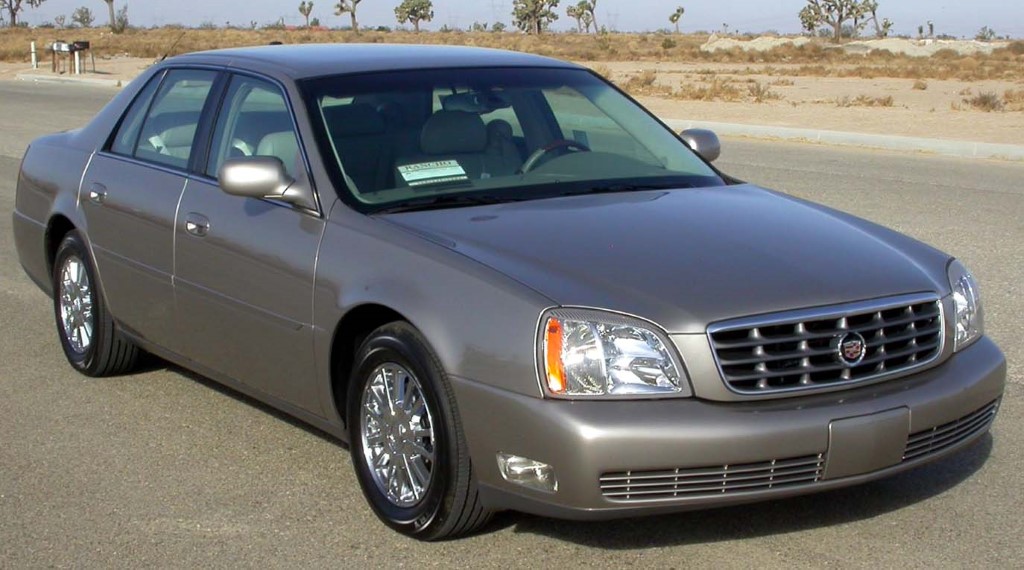 © Wikimedia.org/U.S. National Highway Traffic Safety Administration, CC0
© Wikimedia.org/U.S. National Highway Traffic Safety Administration, CC0
The Checker Marathon is an automobile produced by the Checker Motors Corporation of Kalamazoo, Michigan, between 1961 and 1982. It was marketed as a passenger car for consumers, as opposed to the similar Taxi, which was aimed at fleet buyers. Marathons were produced in both four-door sedan and four-door station wagon forms, and the rarer six-door 9-seater and eight-door, 12-seater 'Aerobus' sedans and wagons. The Marathon was introduced in September 1960 for the 1961 model year, alongside, and later superseding, the Checker Superba Custom and differing from the Superba with its better interior appointments. Originally, it retained the Superba's A10 body code, whereas A9 was the code used for taxis. The exterior of the Marathon had a full-width egg-crate grille, differing from the Superba's narrower grille and inboard parking lights. (Source: Wikipedia.org, CC BY-SA)
 © Wikimedia.org/IFCAR, CC0
© Wikimedia.org/IFCAR, CC0
The Chevrolet 210 or Two-Ten is a midrange car from Chevrolet that was marketed from 1953 until 1957. It took its name by shortening the production series number 2100 by one digit in order to capitalize on the 1950s trend toward numerical auto names. The numerical designation '210' was also sporadically used in company literature. It replaced the Styleline DeLuxe model available in previous years. The 210 was discontinued after the 1957 model year to be replaced by the Biscayne. The Two-Ten series, introduced for the 1953 model year, replaced the Styleline DeLuxe series. It was actually the best-selling Chevrolet model during 1953 and 54, offering a balance of style and luxury appointments unavailable in the base 150 series, but was less costly than the glitzy Bel Air. Two-Tens offered the widest choice of body styles for 1953, including a convertible, Sport Coupe hardtop, two- and four-door sedans, and four-door station wagons. (Source: Wikipedia.org, CC BY-SA)
The Chevrolet Avalanche is a four-door, five or six-passenger pickup truck sharing GM's long-wheelbase chassis used on the Chevrolet Suburban and Cadillac Escalade EXT. Breaking with a long-standing tradition, the Avalanche was unavailable as a GMC, but only as a Chevrolet. Production of the Avalanche started in July 2001[citation needed] and ended April 2013,[citation needed] producing two generations in its lifespan. The Avalanche was launched in September 2001 as a 2002 model on the GMT800 platform. First year Avalanches featured light gray plastic body cladding, intended to provide visual distinction from the Suburban/Yukon XL. Avalanche also gave the public an advance look at the next generation of front fascia designs for the entire GM line. A full-length chrome strip splits each lamp assembly and the grille, with a gold Chevrolet 'bow tie' in the center. The hood and fenders featured aggressive folds, in contrast to the soft box of the other GMT800 models. (Source: Wikipedia.org, CC BY-SA)
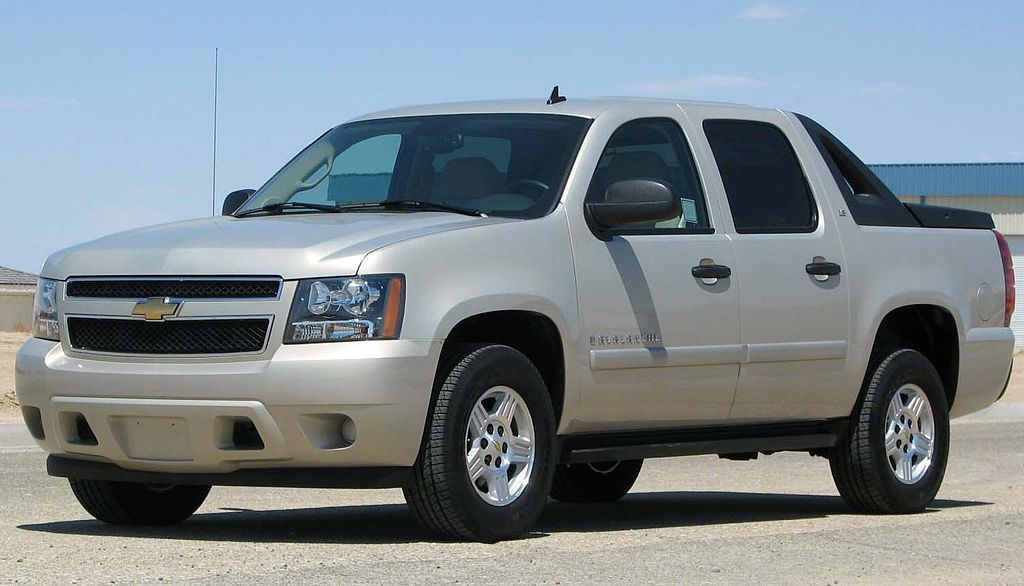 © Wikimedia.org/U.S. National Highway Traffic Safety Administration, CC0
© Wikimedia.org/U.S. National Highway Traffic Safety Administration, CC0
The Chevrolet Camaro is a mid-size American automobile manufactured by Chevrolet, classified as a pony car. It first went on sale on September 29, 1966, for the 1967 model year and was designed to compete with the Ford Mustang. The Camaro shared its platform and major components with the Firebird, produced by General Motors' Pontiac division that was also introduced for 1967. Four distinct generations of the Camaro were developed before production ended in 2002. The nameplate was revived on a concept car that evolved into the fifth-generation Camaro; production started on March 16, 2009. The Camaro will be discontinued at the end of the 2024 model year. However, Chevrolet has stated, 'This is not the end of Camaro's story.' (Source: Wikipedia.org, CC BY-SA)
The Chevrolet Caprice is a full-sized automobile produced by Chevrolet in North America for the 1965 to 1996 model years. Full-size Chevrolet sales peaked in 1965 with over a million sold. It was the most popular car in the U.S. in the 1960s and early 1970s, which, during its lifetime, included the Biscayne, Bel Air, and Impala. Introduced in mid-1965 as a luxury trim package for the Impala four-door hardtop, Chevrolet offered a full line of Caprice models for the 1966 and subsequent model years, including a 'formal hardtop' coupe and an Estate station wagon. The 1971 to 1976 models are the largest Chevrolets ever built. The downsized 1977 and restyled 1991 models were awarded Motor Trend Car of the Year. Production ended in 1996. (Source: Wikipedia.org, CC BY-SA)
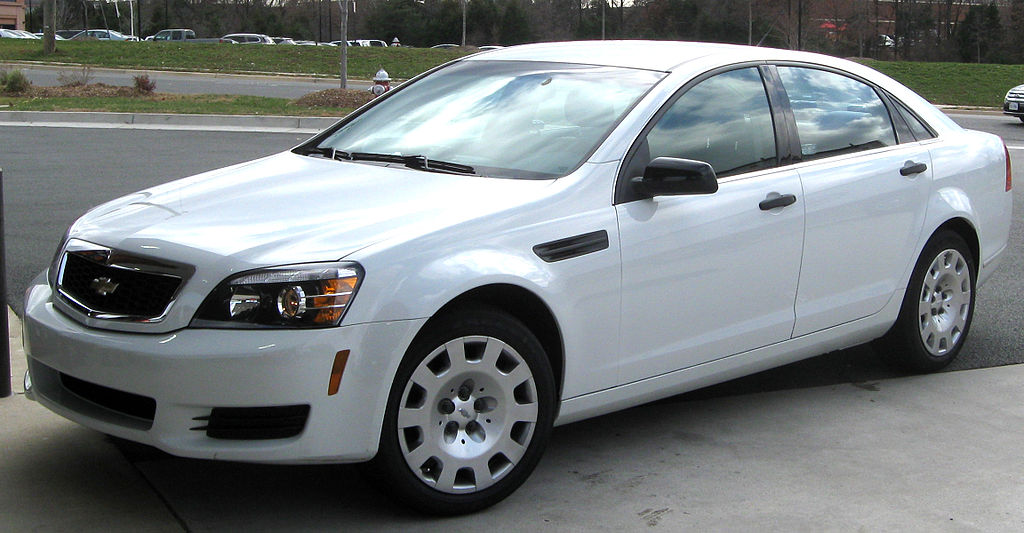 © Wikimedia.org/IFCAR, CC0
© Wikimedia.org/IFCAR, CC0
The Chevrolet Cavalier is a line of compact cars produced by Chevrolet. Serving as the replacement of the Chevrolet Monza, the Cavalier was the second Chevrolet model line to adopt front-wheel drive. Three versions of the Cavalier have been sold, including three generations sold in North America sold from the 1982 to 2005 model years, a version produced by SAIC-GM for China from 2016 to 2021, and a SAIC-GM version produced for Mexico since the 2019 model year. The Cavalier was among the inaugural vehicles of the GM J platform. One of the first 'world cars' of General Motors, the J platform was developed for use by each North American GM division (with the exception of GMC), alongside models from Opel, Vauxhall, and Holden. Though sharing chassis underpinnings, J-body cars from Europe and Australia used slightly different body designs and different powertrains; in Europe, the Vauxhall Cavalier and Opel Ascona were marketed as mid-size cars. Initially a divisional counterpart of the Buick Skyhawk, Cadillac Cimarron, Oldsmobile Firenza, and Pontiac J2000, the Cavalier was primarily marketed alongside the Pontiac Sunbird (renamed the Pontiac Sunfire for 1995). (Source: Wikipedia.org, CC BY-SA)
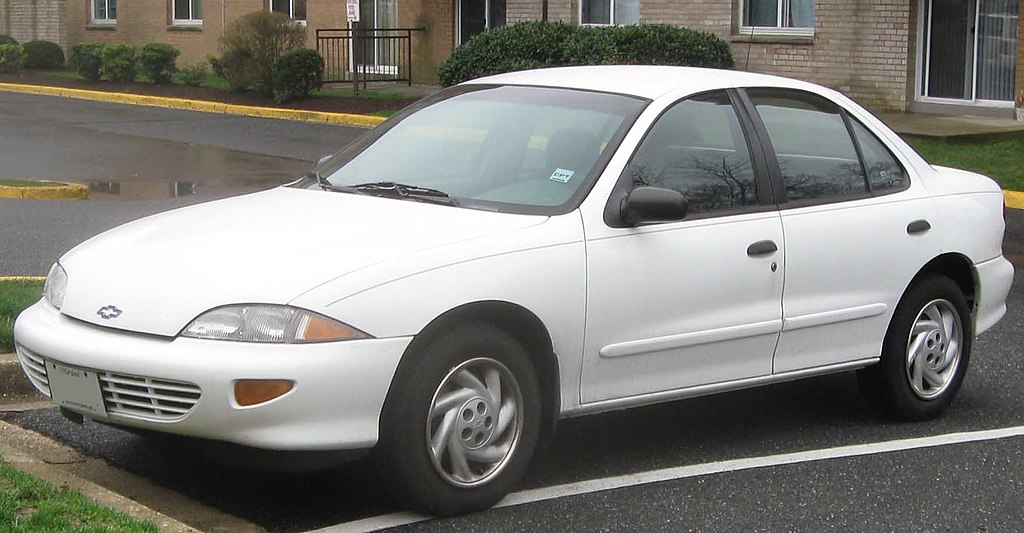 © Wikimedia.org/IFCAR, CC0
© Wikimedia.org/IFCAR, CC0
The Chevrolet Citation is a range of compact cars that was produced by the Chevrolet division of General Motors. The first Chevrolet sold with front-wheel drive, a single generation of the Citation was sold from the 1980 to 1985 model years. The successor of the Chevrolet Nova, the Citation was initially slotted between the Chevrolet Monza and the Chevrolet Malibu in the Chevrolet product line, later replaced by the Chevrolet Cavalier and the Chevrolet Celebrity. The Citation was built on the second-generation compact GM X-platform. For 1980, GM had significantly revised its design, adopting a front-wheel drive layout and significantly decreasing it in size; while directly replacing the Nova, the all-new Citation bore an exterior footprint sized between the subcompact Chevrolet Monza and Chevrolet Vega. Sold alongside the Pontiac Phoenix, Buick Skylark, and Oldsmobile Omega, the Citation was offered in three body styles, including three-door and five-door hatchbacks and a two-door notchback coupe. The 2-door coupe style was similar to but had a distinctive roofline from the Phoenix, Skylark, and Omega, while the 3-door hatchback was exclusive to the Citation. The 5-door hatchback style was shared with the Phoenix, while a 4-door sedan style was offered only on the Skylark and Omega. Alongside a standard trim level, Chevrolet offered the Citation X-11, offering performance-oriented upgrades. (Source: Wikipedia.org, CC BY-SA)
The Chevrolet Colorado, and its counterpart, the GMC Canyon, are series of compact and later mid-sized pickup trucks marketed by American automaker General Motors. They were introduced in 2004 to replace the Chevrolet S-10 and GMC S-15/Sonoma compact pickups. It is named for the U.S. state of Colorado. The Chevrolet Colorado and its twin, the GMC Canyon were jointly designed by GM's North American operations, GM's Brazil operations, and Isuzu, which began selling its own version worldwide in 2002. In late 2005, Isuzu offered a version in North America called the Isuzu i-series. This North American model Isuzu shared North American powertrains, styling, and equipment with the Colorado/Canyon twins and differed from Isuzu's worldwide offering. All Chevrolet, GMC, and Isuzu versions worldwide are based on the GMT355, itself the basis for the GMT 345-based Hummer H3. Most vehicles for markets outside North America are manufactured at a GM plant in Rayong, Thailand. All North American-market vehicles were manufactured by Shreveport Operations. (Source: Wikipedia.org, CC BY-SA)
The Chevrolet Corvair is a compact car manufactured by Chevrolet for model years 1960–1969 in two generations. A response to the Volkswagen Beetle, it remains the only American-designed, mass-produced passenger car with a rear-mounted, air-cooled engine. The Corvair was manufactured and marketed in 4-door sedan, 2-door coupe, convertible, 4-door station wagon, passenger van, commercial van, and pickup truck body styles in its first generation (1960–1964) and as a 2-door coupe, convertible or 4-door hardtop in its second (1965–1969) – with a total production of approximately 1.8 million from 1960 until 1969. The name 'Corvair' originated as a portmanteau of Corvette and Bel Air, a name first applied in 1954 to a Corvette-based concept with a hardtop fastback-styled roof, part of the Motorama traveling exhibition. When applied to the production models, the 'air' part referenced the engine's cooling system. (Source: Wikipedia.org, CC BY-SA)
The Chevrolet Corvette is a two-door, two-passenger luxury sports car manufactured and marketed by Chevrolet since 1953. With eight design generations, noted sequentially from C1 to C8, the Corvette is noted for its performance and distinctive fiberglass or composite panels. It was front-engined through 2019 and mid-engined since. The Corvette is currently the only two-seat sports car produced by a major United States auto manufacturer and it serves as Chevrolet's halo vehicle. In 1953, GM executives accepted a suggestion by Myron Scott, then the assistant director of the Public Relations department, to name the company's new sports car after the corvette, a small maneuverable warship. The first model, a convertible, was introduced at the 1953 GM Motorama as a concept car; production models went on sale later that year. In 1963, the second generation was introduced in coupe and convertible styles. Originally manufactured in Flint, Michigan, and St. Louis, Missouri, the Corvette has been produced in Bowling Green, Kentucky, since 1981, which is also the location of the National Corvette Museum. (Source: Wikipedia.org, CC BY-SA)
The Chevrolet Cruze is a compact car that is produced by General Motors since 2008. It was designated as a globally developed, designed, and manufactured four-door compact sedan, complemented by a five-door hatchback body variant from 2011, and a station wagon in 2012. During its introduction, the Cruze replaces several compact models, including the Chevrolet Optra which was sold internationally under various names, the Chevrolet Cobalt sold exclusively in North America, and the Australasian-market Holden Astra. The Cruze was released in 2008 for the South Korean market as the Daewoo Lacetti Premiere until the phasing out of the Daewoo brand in 2011, when it was renamed to Chevrolet Cruze. In Australasia, the model was sold between 2009 and 2016 as the Holden Cruze. In 2016, the Cruze sedan was restyled and renamed for the Australasian market as the Holden Astra Sedan, as a sedan complement to the Holden Astra family. (Source: Wikipedia.org, CC BY-SA)
The Chevrolet Equinox is a series of crossover SUVs from Chevrolet introduced in 2004 for the 2005 model year. It replaces the North American Chevrolet Tracker and Chevrolet S-10 Blazer. The third-generation Equinox also replaced the first-generation Chevrolet Captiva.[citation needed] A battery electric, or BEV version called the Equinox EV was introduced in 2022 with sales starting in 2023 for the 2024 model year. It adopts a separate design and underpinnings from the ICE-powered Equinox. The Chevrolet Equinox was introduced in 2004 for the 2005 model year. Originally, the Equinox was shown at the 2003 North American International Auto Show. (Source: Wikipedia.org, CC BY-SA)
The Chevrolet Impala (/ɪmˈpælə, -ˈpɑːlə/) is a full-size car built by Chevrolet for model years 1958 to 1985, 1994 to 1996, and 2000 to 2020. The Impala was Chevrolet's popular flagship passenger car and was among the better-selling American-made automobiles in the United States. For its debut in 1958 the Impala was distinguished from other models by its symmetrical triple taillights. The Chevrolet Caprice was introduced as a top-line Impala Sport Sedan for model year 1965, later becoming a separate series positioned above the Impala in 1966, which, in turn, remained above the Chevrolet Bel Air and the Chevrolet Biscayne. The Impala continued as Chevrolet's most popular full-sized model through the mid-1980s. Between 1994 and 1996 the Impala was revised as a 5.7-liter V8–powered version of the Chevrolet Caprice Classic sedan. (Source: Wikipedia.org, CC BY-SA)
The Chevrolet Kodiak and GMC TopKick are a range of medium duty trucks that were produced by the Chevrolet and GMC divisions of General Motors from 1980 to 2009. Introduced as a variant of the medium-duty C/K truck line, three generations were produced. Slotted between the C/K trucks and the GMC Brigadier Class 8 conventional, the Kodiak/TopKick were developed as a basis for vocationally-oriented trucks, including cargo haulers, dump trucks, and similar vehicles; on later generations, both cutaway and cowled-chassis variants were produced for bus use. Following years of declining market share, General Motors (in line with Ford Motor Company) sought to exit heavy-truck manufacturing. After struggling to enter joint ventures or sell the rights to its product line, the company ended production of the Kodiak and TopKick in 2009. The final medium-duty truck, a GMC TopKick 5500, rolled out of Flint Truck Assembly on July 31, 2009. (Source: Wikipedia.org, CC BY-SA)
The Chevrolet LUV and the later Chevrolet LUV D-Max are light pickup trucks designed and manufactured by Isuzu and marketed in the Americas since 1972 by Chevrolet over four generations as rebadged variants of the Isuzu Faster and D-Max. LUV is an acronym for 'light utility vehicle'. Production of the first generation of Chevrolet LUVs, first sold in North America from 1972 as a badge-engineered variant of the Japanese-market Isuzu Faster, ended in 1980. The second generation, launched in 1980 as a 1981 model, was produced by Isuzu in Japan for North America and in Chile by General Motors for the South American market. North American sales ended with the release of the 1982 model year Chevrolet S-10 in 1981. The 1982 model year was the only year the 2.2 liter diesel engine was offered in the United States. (Source: Wikipedia.org, CC BY-SA)
The Chevrolet Lumina is a mid-size car that was produced and marketed by the Chevrolet division of General Motors from 1989 until 2001. The first generation of the Lumina replaced the Chevrolet Celebrity and Chevrolet Monte Carlo under a single nameplate; the mechanically unrelated Chevrolet Lumina APV minivan served as the successor for the Celebrity station wagon. The model line was based on the front-wheel-drive GM10 platform (later designated the GM W platform), shared with Buick, Oldsmobile, and Pontiac. For 1995, the second-generation Lumina was introduced, serving as a substantial exterior revision of the previous generation (the two-door coupe was renamed the Monte Carlo). For the 2000 model year, the Lumina was replaced by the Chevrolet Impala; the model line would retain the W platform through the 2016 model year. (Source: Wikipedia.org, CC BY-SA)
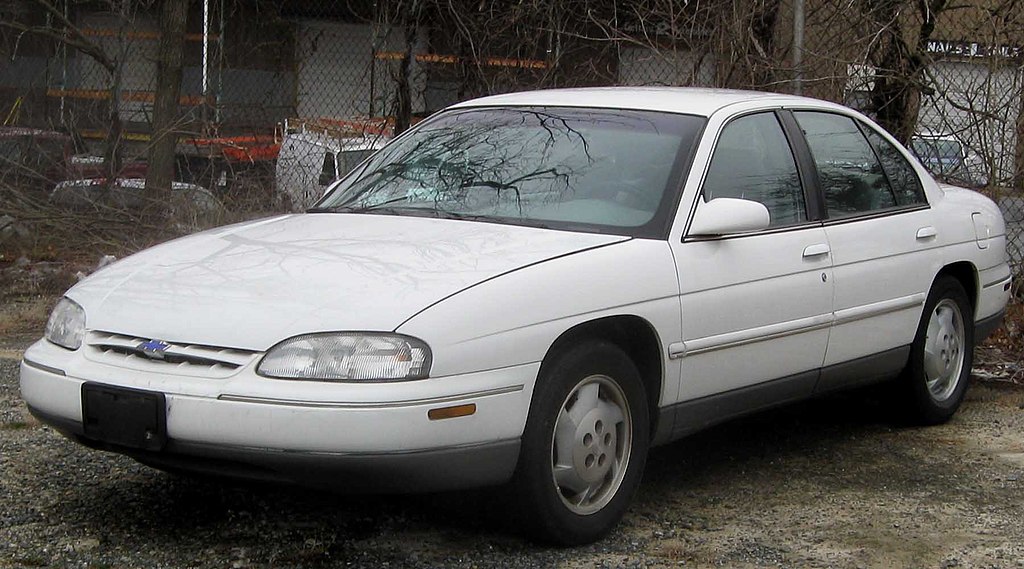 © Wikimedia.org/IFCAR, CC0
© Wikimedia.org/IFCAR, CC0
The Chevrolet Malibu is a mid-size car manufactured and marketed by Chevrolet from 1964 to 1983 and again since 1997. The Malibu began as a trim-level of the Chevrolet Chevelle, becoming its own model line in 1978. Originally a rear-wheel drive intermediate, GM revived the Malibu nameplate as a front-wheel-drive car in 1997. Named after the coastal community of Malibu, California, the Malibu was marketed primarily in North America, with the eighth generation introduced globally. With the discontinuation of the compact Cruze in March 2019, the full-size Impala in March 2020 and the subcompact Sonic in October 2020, the Malibu is currently the only sedan offered by Chevrolet in the U.S. It will be discontinued at the end of the 2025 model year. (Source: Wikipedia.org, CC BY-SA)
The Chevrolet Master and Master Deluxe are American passenger vehicles manufactured by Chevrolet between 1933 and 1942 to replace the 1933 Master Eagle. It was the more expensive model in the Chevrolet range at this time, with the Standard Mercury providing an affordable product between 1933 and 1937. Starting with this generation, all GM cars shared a corporate appearance as a result of the Art and Color Section headed by Harley Earl. From 1940 a more expensive version based on the Master Deluxe was launched called the Special Deluxe. The updated corporate appearance introduced a concealed radiator behind a façade with a grille. (Source: Wikipedia.org, CC BY-SA)
The Chevrolet Monza is a subcompact automobile produced by Chevrolet for the 1975 through 1980 model years. The Monza is based on the Chevrolet Vega, sharing its wheelbase, width, and standard inline-four engine. The car was designed to accommodate the GM-Wankel rotary engine, but due to mediocre fuel economy and emissions-compliance issues the engine was cancelled, and a V8 engine option was substituted. The Monza name has also been used for several other cars. Introduced for the 1975 model year, the Monza 2+2 and Monza Towne Coupe competed with the Ford Mustang II and other sporty coupes. General Motors' H-body variants, the Buick Skyhawk and Oldsmobile Starfire, were produced using the Monza 2+2's body with grille and trim variations and Buick's 3.8 liter V6 engine. The Pontiac Sunbird variant was introduced for the 1976 model year, initially offered only in the Monza Towne Coupe body with the 2+2 hatchback added for the 1977 model year. The Monza nameplate originated in mid-1960 for the sport version of the Chevrolet Corvair. (Source: Wikipedia.org, CC BY-SA)
The Chevrolet Chevy II/Nova is a small automobile manufactured by Chevrolet, and produced in five generations for the 1962 through 1979, and 1985 through 1988 model years. Nova was the top model in the Chevy II lineup through 1968. The Chevy II nameplate was dropped after 1968, with Nova becoming the nameplate for all of the 1969 through 1979 models. Built on the X-body platform, the Nova was replaced by the 1980 Chevrolet Citation introduced in the spring of 1979. The Nova nameplate returned in 1985, produced through 1988 as a S-car based, NUMMI manufactured, subcompact based on the front wheel drive, Japan home-based Toyota Sprinter. (Source: Wikipedia.org, CC BY-SA)
The Chevrolet Opala is a Brazilian mid-size car sold under the Chevrolet brand in South America from 1969 to 1992, by General Motors do Brasil. It was derived from the German Opel Rekord Series C, Opel Commodore Series A, but used local design styling[citation needed] and engines derived from North American designs. GM manufactured about one million units including the Opala sedan, Opala Coupé, and the station wagon variant, the Opala Caravan. It was replaced by the Chevrolet Omega in 1992, also an Opel spinoff. It was the first passenger car built by GM in Brazil by the General Motors do Brasil division. A luxury version of the Opala was marketed as the Chevrolet Diplomata. It was used by the Brazilian Federal Police for many years. The military government issued Opalas to its agents through the 1970s. Its reliability and easy maintenance made the Opala the choice of many taxi drivers and was also popular on racetracks.[citation needed] (Source: Wikipedia.org, CC BY-SA)
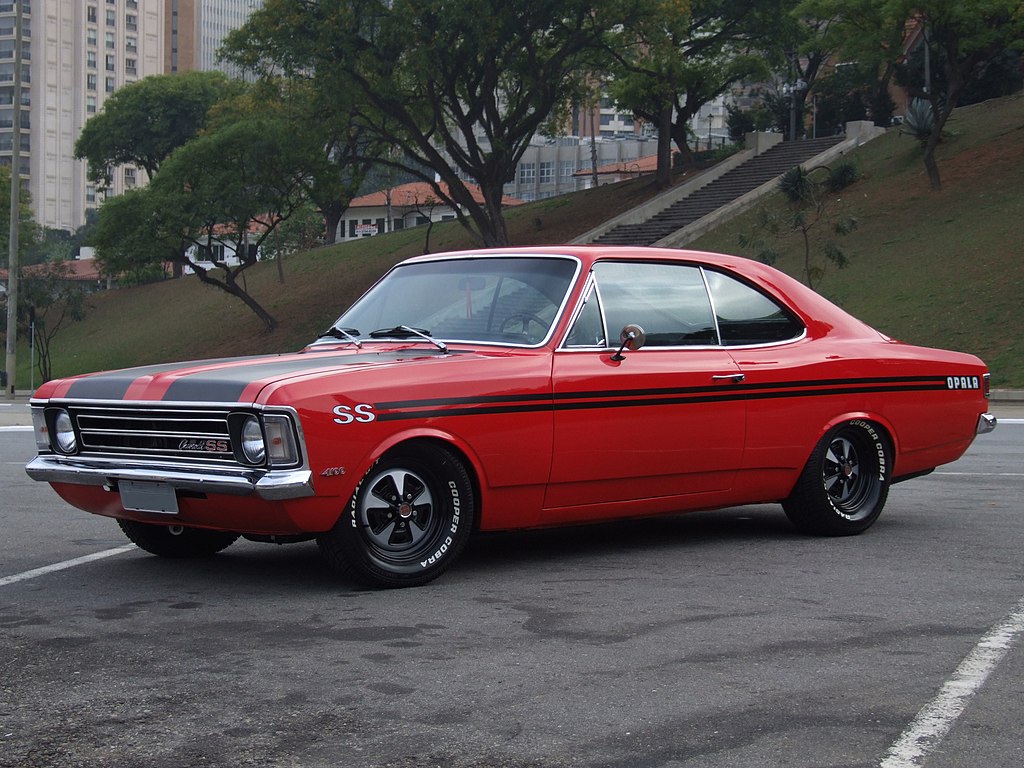 © Wikimedia.org/Niemann333, CC BY-SA
© Wikimedia.org/Niemann333, CC BY-SA
The Chevrolet S-10 is a compact pickup truck that was produced by Chevrolet. It was the first domestically built compact pickup of the big three American automakers. When it was first introduced as a 'quarter-ton pickup' in 1981 for the 1982 model year, the GMC version was known as the S-15 and later renamed the GMC Sonoma. A high-performance version was released in 1991 and given the name of GMC Syclone. The pickup was also sold by Isuzu as the Hombre from 1996 through 2000, but only in North America. There was also an SUV version, the Chevrolet S-10 Blazer/GMC S-15 Jimmy. An electric version was leased as a fleet vehicle in 1997 and 1998. Together, these pickups are often referred to as the S-series. (Source: Wikipedia.org, CC BY-SA)
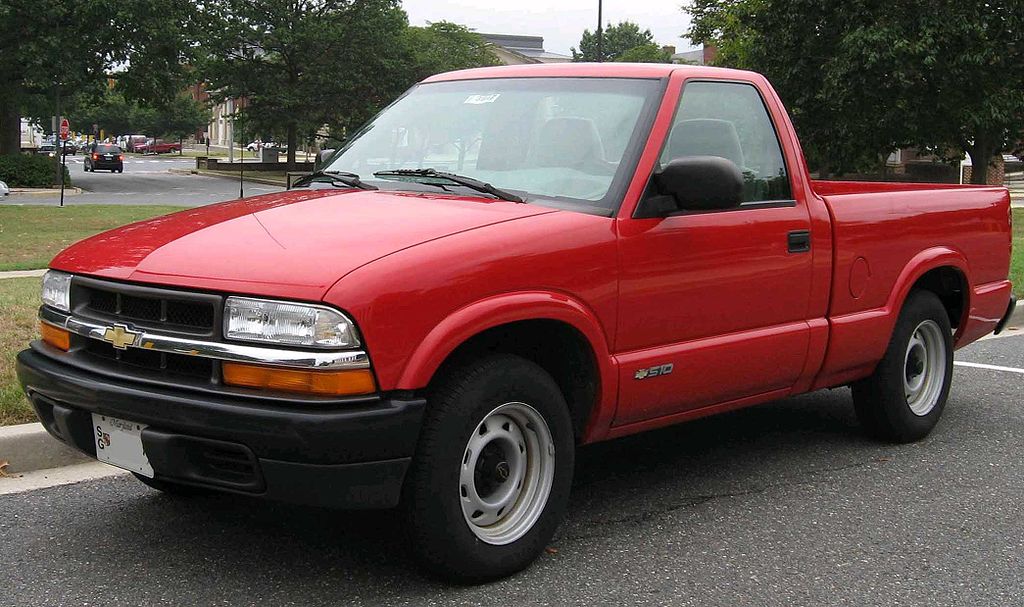 © Wikimedia.org/IFCAR, CC0
© Wikimedia.org/IFCAR, CC0
The Chevrolet SSR (Super Sport Roadster) is a retro-styled retractable hardtop convertible pickup truck manufactured by Chevrolet between 2003 and 2006. The 2003 and 2004 model years used General Motors' 5.3 L 300 hp Vortec 5300 V8. Performance was 7.7 seconds for 0–60 mph (0–97 km/h) with a 15.9 second quarter mile run at 86.4 mph. The 2005 SSR used the 390 hp (291 kW) LS2 V8 also found in the C6 Corvette, Trailblazer SS, and Pontiac GTO, and also offered a manual transmission option, the six-speed Tremec, for the first time. For the 2005 model year, the LS2 engine featured minor modifications that boosted its output to 390 hp (395-400 for 2006), respectively. Performance improved dramatically with the LS2; the 6-speed manual version had an advertised 0-60 mph (97 km/h) time of 5.29 seconds. In addition, GM badges were added to the vehicle. (Source: Wikipedia.org, CC BY-SA)
 © Wikimedia.org/IFCAR, CC0
© Wikimedia.org/IFCAR, CC0
The Chevrolet Silverado is a range of trucks manufactured by General Motors under the Chevrolet brand. Introduced for the 1999 model year, the Silverado is the successor to the long running Chevrolet C/K model line. Taking its name from the top trim level from the Chevrolet C/K series, the Silverado is offered as a series of full-size pickup trucks, chassis cab trucks, and medium-duty trucks. The fourth generation of the model line was introduced for the 2019 model year. The Chevrolet Silverado shares mechanical commonality with the GMC Sierra; GMC ended the use of the C/K nomenclature a model generation prior to Chevrolet. In Mexico, high trim level versions of the Silverado use the Chevrolet Cheyenne name. Competing against the Ford F-Series, Ram Pickup, Nissan Titan, and Toyota Tundra, the Silverado is among the best-selling vehicles in the United States, having sold over 12 million examples since its introduction in 1999. (Source: Wikipedia.org, CC BY-SA)
The Chevrolet Suburban is a series of automobiles built by the Chevrolet division of General Motors. The name started in 1934 for the 1935 U.S. model year, making it the longest continuously used automobile nameplate in production. It has traditionally been one of General Motors' most profitable vehicles. The 1935 first generation Carryall Suburban was one of the first production all-metal bodied station wagons. It now has a full-size SUV body style and comes with three engine options: a 5.3 liter V8, 6.2 liter V8 or a 3.0-liter inline-6 turbo diesel. The Suburban was additionally produced under the GMC marque until the GMC version was rebranded as the Yukon XL. It was also briefly marketed as a Holden. For most of its recent history, the Suburban has been a station wagon−bodied version of the Chevrolet pickup truck, including the Chevrolet C/K and Silverado series of truck-based vehicles. Cadillac offers a version called the Escalade ESV. (Source: Wikipedia.org, CC BY-SA)
The Chevrolet Tahoe, and its badge engineered GMC Yukon counterpart, are full-size SUVs from General Motors, offered since 1994 and 1991, respectively. Since 1982, Chevrolet and GMC sold two different-sized SUVs under their 'Blazer' and 'Jimmy' nameplates, by introducing the smaller S-10 Blazer and GMC S-15 Jimmy for the 1983 model year, below the full-size Blazer and Jimmy models. This situation lasted into the early 1990s. GMC first rebadged the full-size Jimmy as the 'Yukon' in 1991. Chevrolet however waited until 1994, when they rebadged the redesigned mid-size S-10 Blazer as their 'new Blazer', while renaming the full-size Blazer as the 'Tahoe'. The name Tahoe refers to the rugged and scenic area surrounding Lake Tahoe in the western United States. The name Yukon refers to the Yukon territory of northern Canada. (Source: Wikipedia.org, CC BY-SA)
The Chevrolet Traverse is a full-size crossover SUV with three-row seating built by General Motors. It is built on the same platform as the GMC Acadia and Buick Enclave, known as the Lambda platform for first generation, and the C1XX for second generation. It also shares the C1XX platform with the Cadillac XT6. It is the successor to the TrailBlazer body-on-frame SUV and Uplander minivan. The second generation model debuted in showrooms in the summer of 2017. Starting with the 2019 model year, the Traverse was slotted above the new mid-size Chevrolet Blazer as part of Chevrolet's plans to expand its SUV lineup. (Source: Wikipedia.org, CC BY-SA)
The Chevrolet Vega is a subcompact automobile that was manufactured and marketed by GM's Chevrolet subdivision from 1970 to 1977. Available in two-door hatchback, notchback, wagon, and sedan delivery body styles, all models were powered by an inline four-cylinder engine with a lightweight, aluminum alloy cylinder block. The Vega first went on sale in Chevrolet dealerships on September 10, 1970. Variants included the Cosworth Vega, a short-lived limited-production performance model, introduced in the spring of 1975. The Vega received praise and awards at its introduction, including 1971 Motor Trend Car of the Year. Subsequently, the car became widely known for a range of problems related to its engineering, reliability, safety, propensity to rust, and engine durability. Despite a series of recalls and design upgrades, the Vega's problems tarnished both its own as well as General Motors' reputation. Production ended with the 1977 model year. (Source: Wikipedia.org, CC BY-SA)
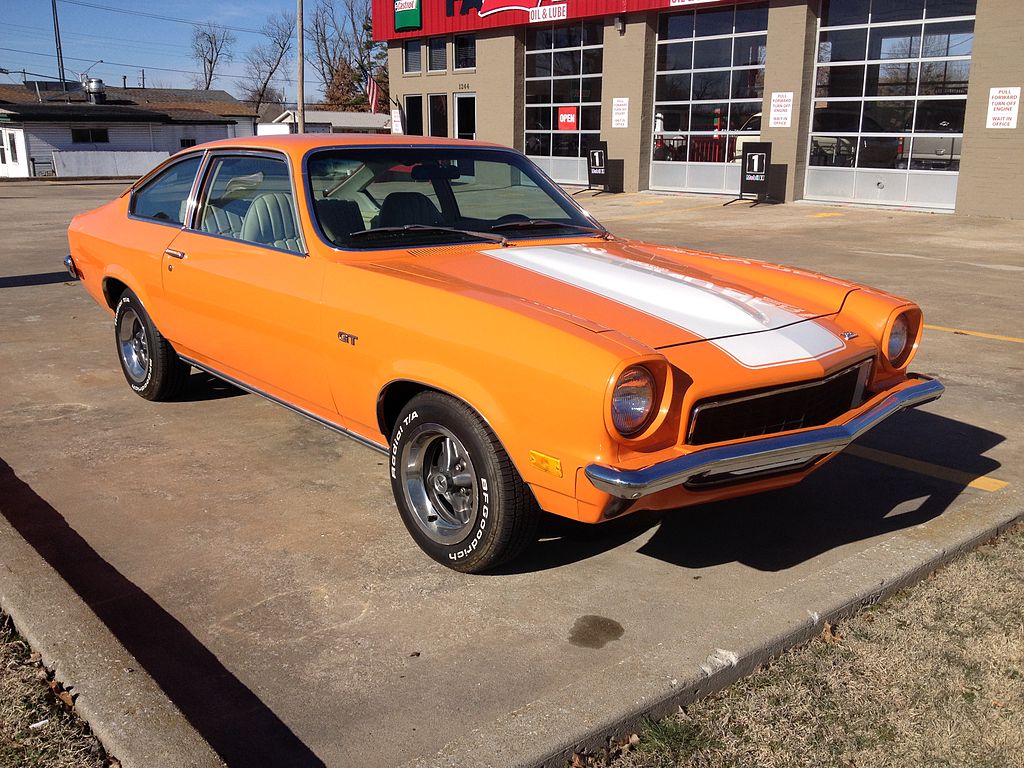 © Wikimedia.org/wallerdog, CC BY-SA
© Wikimedia.org/wallerdog, CC BY-SA
The Chevrolet Volt is a plug-in hybrid manufactured by General Motors, also marketed in rebadged variants as the Holden Volt in Australia and New Zealand and the Buick Velite 5 in China, and with a different fascia as the Vauxhall Ampera in the United Kingdom and as the Opel Ampera in the remainder of Europe. Volt production ended in February 2019. Sales of the 2011 Volt began in the United States in mid-December 2010, followed by various European countries and other international markets in 2011. Global combined Volt/Ampera-family sales totaled about 177,000 units by the end of October 2018. The U.S. is the leading market, with 157,054 Volts delivered through the end of 2019, followed by Canada with 16,653 Volts sold through September 2018. Just over 10,000 Opel/Vauxhall Ampera cars had been sold in Europe as of June 2016. Until December 2018, the Volt/Ampera family of vehicles was the world's all-time bestselling plug-in hybrid vehicle. As of December 2019, the Chevrolet Volt is listed as the all-time top-selling plug-in hybrid in the American market. (Source: Wikipedia.org, CC BY-SA)
The Chrysler 300 is a full-size car manufactured and marketed by Stellantis North America (and its predecessor companies) as a four-door sedan and station wagon in its first generation (model years 2005–2010) and solely as a four-door sedan in its second and current generation (model years 2011–present). The second generation 300 was marketed as the Chrysler 300C in the United Kingdom and Ireland and as the Lancia Thema in the remainder of Europe. The Chrysler 300 continues a tradition of large front engine, rear-wheel drive V8-powered luxury sedans the company has offered, starting in the 1940s with the Chrysler Saratoga and Chrysler New Yorker, followed by the Chrysler Windsor, Chrysler Newport and the Chrysler Cordoba, with the last rear wheel drive sedan, the Chrysler Fifth Avenue that ended production in 1989. (Source: Wikipedia.org, CC BY-SA)
The Newport was a name used by Chrysler for both a hardtop body designation and also for its lowest priced model between 1961 and 1981. Chrysler first used the Newport name on a 1940 show car, of which five vehicles were produced. The Newport continued the tradition of a large, comfortable luxurious coupe and sedan, while offering a modestly priced product in comparison to the Chrysler New Yorker and Chrysler Imperial. The Newport gradually replaced the Chrysler Windsor which originally replaced the Chrysler Royal. The Newport was initially the brand name for the Windsor with a hardtop body style, then was used for coupes, sedans and station wagons in later decades. (Source: Wikipedia.org, CC BY-SA)
The Chrysler Pacifica is a minivan produced by the Chrysler division of Stellantis. It is unrelated to the discontinued crossover and concept vehicles by the same name and replaced the Chrysler Town & Country for the 2017 model year. It is positioned as the higher-end Chrysler minivan, above the Dodge Grand Caravan until 2020 and above the Chrysler Voyager (rebadged as the Chrysler Grand Caravan in Canada) since 2020. The minivan is produced with two powertrains, a 3.6 L gasoline-powered engine and a plug-in hybrid. The plug-in hybrid version has a 16-kWh lithium-ion battery that can propel the car up to 33 mi (53 km) on electric power alone. The gasoline-only version of the Pacifica minivan went on sale in mid-2016, while the plug-in hybrid version became available in early 2017. (Source: Wikipedia.org, CC BY-SA)
The Chrysler TC by Maserati is a jointly developed car by Chrysler and Maserati. It was positioned as a grand tourer and introduced at the 1986 Los Angeles Auto Show.[citation needed] It is a 'Q' body built on a modified second-generation Chrysler K platform. After two years of development delays, the TC became available in late-1988 and a total of 7,300 units (the minimum required under the contract) were manufactured in Milan, Italy, through 1990. All cars sold as 1991 models were manufactured in 1990. (Source: Wikipedia.org, CC BY-SA)
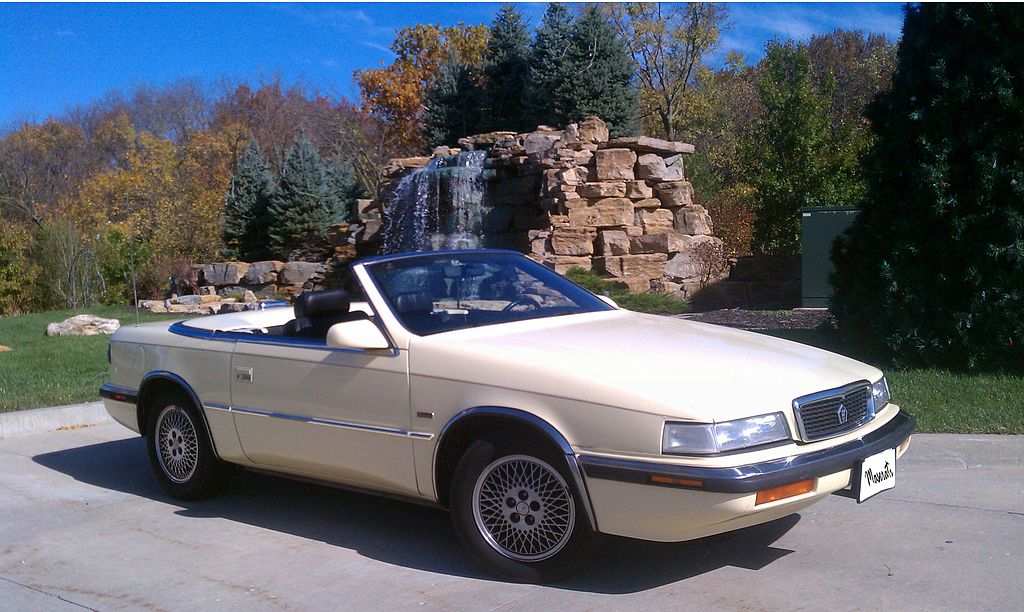 © Wikimedia.org/Mesatrooper, CC BY-SA
© Wikimedia.org/Mesatrooper, CC BY-SA
The Chrysler Town & Country is a minivan that was manufactured and marketed by Chrysler from 1990 to the 2016 model years. The third of the Chrysler minivans introduced, the 1990 Town & Country shared its nameplate with the flagship Chrysler station wagon produced from 1941 to 1988. Five generations of the model line were produced, with the Town & Country positioned as the flagship luxury minivan trim package, slotted above the extended wheelbase Dodge Grand Caravan and Plymouth Grand Voyager. After the 2016 model year, Chrysler retired the Town & Country nameplate for Chrysler-division minivans, with the sixth-generation 2017 vehicles adopting the Chrysler Pacifica nameplate. At the time the Town & Country was withdrawn, Chrysler marked the sale of its 12 millionth minivans (combined under three nameplates). Produced nearly continuously for 75 years, the Town & Country nameplate is the longest-produced Chrysler nameplate and is second only to the Chevrolet Suburban in worldwide automotive history. (Source: Wikipedia.org, CC BY-SA)
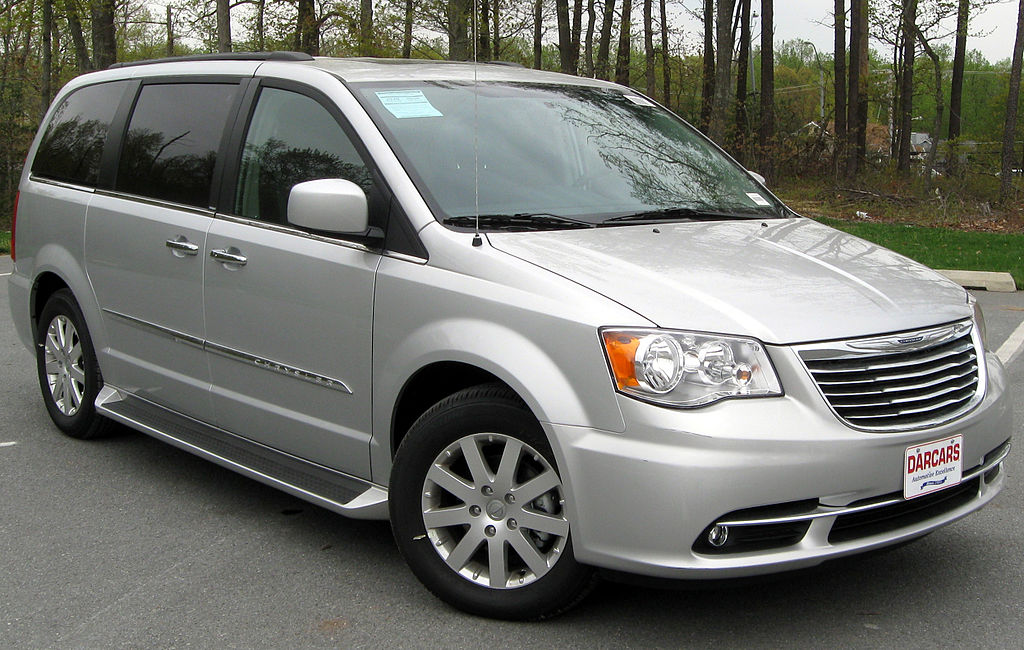 © Wikimedia.org/IFCAR, CC0
© Wikimedia.org/IFCAR, CC0
The Citroën 2CV (French: deux chevaux(-vapeur), pronounced [dø ʃ(ə)vo (vapœʁ)], lit. 'two steam horse(power)s', meaning 'two taxable horsepower') is an air-cooled front-engine, front-wheel-drive, economy family car, introduced at the 1948 Paris Mondial de l'Automobile, and manufactured by Citroën for model years 1948–1990. Conceived by Citroën Vice-President Pierre Boulanger to help motorise the large number of farmers still using horses and carts in 1930s France, the 2CV has a combination of innovative engineering and straightforward, utilitarian bodywork. The 2CV featured overall low cost of ownership, simplicity of maintenance, an easily serviced air-cooled engine (originally offering 9 hp), and minimal fuel consumption. In addition, it had literally been designed to cross a freshly ploughed field, because of the great lack of paved roads in France then; with a long-travel suspension system, that connects front and rear wheels, giving a very soft ride. (Source: Wikipedia.org, CC BY-SA)
The Citroën DS (French pronunciation: [si.tʁɔ.ɛn de.ɛs]) is a front mid-engined, front-wheel drive executive car manufactured and marketed by Citroën from 1955 to 1975, in fastback/sedan, wagon/estate, and convertible body configurations, across three series of one generation. Marketed with a less expensive variant, the Citroën ID, the DS was known for its aerodynamic, futuristic body design; unorthodox, quirky and innovative technology, and it set new standards in ride quality, handling, and braking — thanks to both being the first mass production car equipped with hydropneumatic suspension, as well as disc brakes. The 1967 series 3 also introduced directional headlights to a mass-produced car. (Source: Wikipedia.org, CC BY-SA)

Time for recess! Post a comment, ask a question or write a review. Feel free to let us know what you think!
yo soy de El Salvador y me llamo Helen Ingrid Pero tube que venirme para los estados Unidos
tengo 14 años y la mayoria me salio bien y no estudie ni nada solo por que mi padre me enseño cuando salia de viaje con el
Muy buenos videos, las orientaciones son excelentes, importantes para evitar accidentes
something in this test is not right. there were only 2 questions that i crossed out with an and you can check that it is a system error and not main. And i have already done this test 3 Times and it does the same thing to me.
Muchas gracias, por permitir aprender y por hacerlo sin costo alguno. Muy . Felicitaciones. He visto libros que ofertan Online en todos los idiomas y Aplicaciones que me han comentado que resultan cuando son pagadas. Igual los libros los ofrecen con Vídeos, exámen simulado y de diferentes formas, el cliente lo elije y paga. Pero lo que ofrecen gratuito es valiosa ayuda, pero quizás lo determinante y recomendable es comprar para ir a lo seguro y después ir a la Escuela.
Gracias por los ejemplos para el test. Una pregunta, alguien ha pasado el exámen estudiando de aqui? Yo ya hice el exámen en inglés y las preguntas eran bastante complejas. Hablo el inglé igual que el espanol pero ahora quiero tratar en espanol a ver si asi lo paso... Si alguien lo ha pasado solo con edsto o sabe de algun libro porfa me avisa? Gracias!!!
TEST ACTUALIZADO a 2024 con todas las preguntas revisadas acá: https://www.daypo.com/examen-teorico-manejo-sertracen-panama-2024-actualizado.html
hola , pague poder desbloquear las demás prácticas pero no me llego el email alguien a tubo la misma situación ?